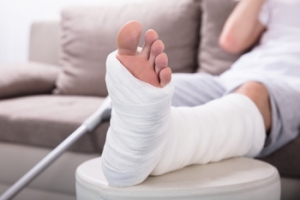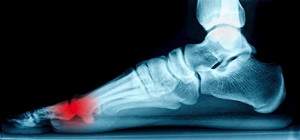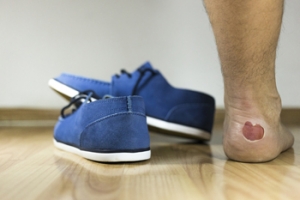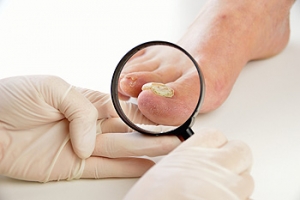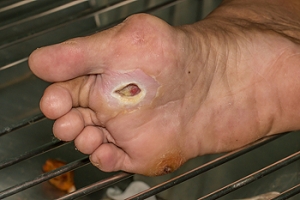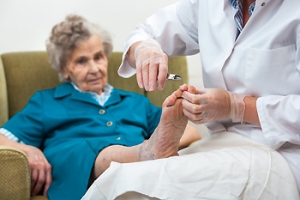Connect With Us
Featured Articles
Super User
What Is a Metatarsal Fracture?
The metatarsals are five long, slim bones that run the length of the foot to the base of the toes. They are a common site of fractures. The fifth metatarsal bone, which is located on the outside of the foot and connects your pinky toe to the rest of the foot, is the most likely foot bone to be fractured due to an acute injury. Metatarsals can also be the site of stress fractures, which occur over time due to overuse. Like other fractures, metatarsal fractures may be open or closed. Open fractures refer to broken bones that break through the skin, while closed fractures are internal. Metatarsal fractures can also be displaced, where the bones have become misaligned, or nondisplaced. If you suspect that you may have broken a bone in your foot, it is suggested that you see a podiatrist as soon as possible.
A broken foot requires immediate medical attention and treatment. If you need your feet checked, contact Dr. Thong V. Truong from California. Our doctor can provide the care you need to keep you pain-free and on your feet.
Broken Foot Causes, Symptoms, and Treatment
A broken foot is caused by one of the bones in the foot typically breaking when bended, crushed, or stretched beyond its natural capabilities. Usually the location of the fracture indicates how the break occurred, whether it was through an object, fall, or any other type of injury.
Common Symptoms of Broken Feet:
- Bruising
- Pain
- Redness
- Swelling
- Blue in color
- Numbness
- Cold
- Misshapen
- Cuts
- Deformities
Those that suspect they have a broken foot shoot seek urgent medical attention where a medical professional could diagnose the severity.
Treatment for broken bones varies depending on the cause, severity and location. Some will require the use of splints, casts or crutches while others could even involve surgery to repair the broken bones. Personal care includes the use of ice and keeping the foot stabilized and elevated.
If you have any questions please feel free to contact our office located in Chico, CA . We offer the newest diagnostic and treatment technologies for all your foot and ankle needs.
Causes, Symptoms, and Treatment for a Broken Foot
One out of ten broken bones is reported to be in the feet. When an object crushes, bends, or stretches the bone beyond acceptable ranges, bones break. A break in the foot is either a fracture or a straight break.
The location of any break can tell you how the break happened. Toes, for instance, break typically as a result of something being kicked hard and with great force. Heel breaks almost always are a result of an improper landing from a tall height. Twists or sprains are the other two frequent occurrences. As with all usual breaks, they result from unexpected accident or sudden injury. As with stress fractures, breaks form as a process over time from repeated stress on already present cracks. Runners, dancers, and gymnasts are the usual athletes who receive this type of break. Stress fractures result from incredible pressure on the feet. It is no surprise these athletes bear the majority of reported fractures.
Pain, swelling, bruising, and redness are all indicative of the typical symptoms from a broken foot. Severe pain—to the point of not being able to walk—usually depends on the location of the break in the foot. Toes are on the lower scale of pain threshold, but heels are high, as are a few other particular bones. As the severity of the broken foot increases, symptoms like blueness, numbness, misshaping of the foot, cuts, or deformities will become apparent. These symptoms indicate the need to see a medical professional with access to an x-ray facility.
Prior to seeing a specialist, precautions should be taken to reduce pain and swelling. Elevate and stabilize the foot, and refrain from moving it. Immobilization of the foot is the next priority, so creating a homemade splint is acceptable. Keep in mind that while creating a splint, any increase of pain or cutting off blood circulation means that the splint should be removed immediately. Use ice to decrease swelling and relieve pain symptoms.
When dealing with a medical center, the patient should note that the treatment can vary. The treatment will depend on the severity of the fracture and the cause of the break. Crutches, splits, or casts are common treatments while surgery has been known to be used in more severe cases in order to repair the break in the bones.
Two Tiny Bones Can Cause a Giant Pain
Sesamoid bones are unique in that they are not connected to other bones (which is normally the case with bones). Sesamoids are either embedded in muscles or connected to tendons. The kneecap (patella bone) is the largest sesamoid bone in the body. There are two little sesamoids in the foot which help the big toe move, enable the foot to push off, and serve as shock absorbers for the ball of the foot. When these sesamoids become fractured, irritated or inflamed due to repetitive pressure, overuse, or other contributing factors, it is known as sesamoiditis. Sesamoiditis can be quite painful, making it very difficult to walk. If sesamoiditis is not treated properly and promptly, other areas of the foot may become inflamed or even injured. If you are experiencing pain under the big toe and are having difficulty bending and straightening it, consult a podiatrist to see if you have sesamoiditis and receive proper care if you do.
Sesamoiditis is an unpleasant foot condition characterized by pain in the balls of the feet. If you think you’re struggling with sesamoiditis, contact Dr. Thong V. Truong of California. Our doctor will treat your condition thoroughly and effectively.
Sesamoiditis
Sesamoiditis is a condition of the foot that affects the ball of the foot. It is more common in younger people than it is in older people. It can also occur with people who have begun a new exercise program, since their bodies are adjusting to the new physical regimen. Pain may also be caused by the inflammation of tendons surrounding the bones. It is important to seek treatment in its early stages because if you ignore the pain, this condition can lead to more serious problems such as severe irritation and bone fractures.
Causes of Sesamoiditis
- Sudden increase in activity
- Increase in physically strenuous movement without a proper warm up or build up
- Foot structure: those who have smaller, bonier feet or those with a high arch may be more susceptible
Treatment for sesamoiditis is non-invasive and simple. Doctors may recommend a strict rest period where the patient forgoes most physical activity. This will help give the patient time to heal their feet through limited activity. For serious cases, it is best to speak with your doctor to determine a treatment option that will help your specific needs.
If you have any questions please feel free to contact our office located in Chico, CA . We offer the newest diagnostic and treatment technologies for all your foot and ankle needs.
Signs of Rheumatoid Arthritis in the Feet
 Rheumatoid Arthritis (RA) is a type of arthritis in which the body’s immune system mistakenly attacks the body’s own joints. This causes inflammation in and around the joints, making the tissue lining in the joints thicken. While any joints in the body can be affected by RA, some of the most commonly affected ones are those located in the feet. Signs of RA in the feet include joint stiffness, soreness, pain, swelling, numbness, tingling, and a decreased range of motion. The severity of the symptoms may vary from day to day. RA is a chronic condition that requires medical management. If you have RA in your feet, a podiatrist can assist you in managing your pain levels, increasing your mobility, and improving your overall quality of life.
Rheumatoid Arthritis (RA) is a type of arthritis in which the body’s immune system mistakenly attacks the body’s own joints. This causes inflammation in and around the joints, making the tissue lining in the joints thicken. While any joints in the body can be affected by RA, some of the most commonly affected ones are those located in the feet. Signs of RA in the feet include joint stiffness, soreness, pain, swelling, numbness, tingling, and a decreased range of motion. The severity of the symptoms may vary from day to day. RA is a chronic condition that requires medical management. If you have RA in your feet, a podiatrist can assist you in managing your pain levels, increasing your mobility, and improving your overall quality of life.
Arthritis can be a difficult condition to live with. If you are seeking treatment, contact Dr. Thong V. Truong from California. Our doctor can provide the care you need to keep you pain-free and on your feet.
Arthritic Foot Care
Arthritis is a joint disorder that involves the inflammation of different joints in your body, such as those in your feet. Arthritis is often caused by a degenerative joint disease and causes mild to severe pain in all affected areas. In addition to this, swelling and stiffness in the affected joints can also be a common symptom of arthritis.
In many cases, wearing ill-fitting shoes can worsen the effects and pain of arthritis. Wearing shoes that have a lower heel and extra room can help your feet feel more comfortable. In cases of rheumatoid arthritis, the arch in your foot may become problematic. Buying shoes with proper arch support that contour to your feet can help immensely.
Alleviating Arthritic Pain
- Exercises that stretch the foot can prevent further pain and injury and increase mobility
- Most of the pain can be alleviated with anti-inflammatory drugs, heat, and topical medications
- Massages can help temporarily alleviate pain.
It is best to see your doctor for the treatment that is right for your needs and symptoms. Conditions vary, and a podiatrist can help you determine the right method of care for your feet.
If you have any questions, please feel free to contact our office located in Chico, CA . We offer the newest diagnostic tools and technology to treat your foot and ankle needs.
Shoes and Blisters on the Feet
 Friction is the most common cause of blisters on the feet. They can happen as a result of wearing shoes that do not fit correctly or from medical conditions that include psoriasis and eczema. It is defined as a small pocket of fluid that forms over the damaged area. This helps to protect the affected area as the healing process occurs. It is the body’s natural healing technique that will gradually drain once new skin has formed. It may be beneficial to wear a protective covering over the blister until it drains naturally, as this may help to prevent it from becoming infected. If you have a blister on your foot, please consult with a podiatrist who can provide a proper examination and offer more extensive treatment advice.
Friction is the most common cause of blisters on the feet. They can happen as a result of wearing shoes that do not fit correctly or from medical conditions that include psoriasis and eczema. It is defined as a small pocket of fluid that forms over the damaged area. This helps to protect the affected area as the healing process occurs. It is the body’s natural healing technique that will gradually drain once new skin has formed. It may be beneficial to wear a protective covering over the blister until it drains naturally, as this may help to prevent it from becoming infected. If you have a blister on your foot, please consult with a podiatrist who can provide a proper examination and offer more extensive treatment advice.
Blisters may appear as a single bubble or in a cluster. They can cause a lot of pain and may be filled with pus, blood, or watery serum. If your feet are hurting, contact Dr. Thong V. Truong of California. Our doctor can provide the care you need to keep you pain-free and on your feet.
Foot Blisters
Foot blisters are often the result of friction. This happens due to the constant rubbing from shoes, which can lead to pain.
What Are Foot Blisters?
A foot blister is a small fluid-filled pocket that forms on the upper-most layer of the skin. Blisters are filled with clear fluid and can lead to blood drainage or pus if the area becomes infected.
Symptoms
(Blister symptoms may vary depending on what is causing them)
- Bubble of skin filled with fluid
- Redness
- Moderate to severe pain
- Itching
Prevention & Treatment
In order to prevent blisters, you should be sure to wear comfortable shoes with socks that cushion your feet and absorb sweat. Breaking a blister open may increase your chances of developing an infection. However, if your blister breaks, you should wash the area with soap and water immediately and then apply a bandage to the affected area. If your blisters cause severe pain it is important that you call your podiatrist right away.
If you have any questions, please feel free to contact our office located in Chico, CA . We offer the newest diagnostic and treatment technologies for all your foot care needs.
Blisters
Blisters are pockets of fluid that occur under the top layer of your skin. These fluid pockets are usually filled with pus, blood, or serum. Blisters may itch or hurt and can appear as a single bubble or in clusters.
The most common types of blisters are friction blisters. This type of blister may be caused by wearing shoes that are too tight. Friction blisters can also occur on the hands. A change in temperature may also cause blisters on the feet. In the freezing air, frostbite on your toes can lead to blisters, as well as sunburn from hot weather.
The best way to treat a blister is to keep it clean and dry. Most blisters will get better on their own. Once the skin absorbs the fluid within the blister, it will flatten and eventually peel off. You should avoid popping your blister unless you podiatrist does it for you. Additional treatment options include applying an ice pack to the blister or using over-the-counter blister bandages to cover the affected area.
If your blister becomes discolored, inflamed, or worsens it is advised that you speak to your podiatrist. Blisters that are yellow, green, or purple may be infected and require immediate medical attention. Blisters that are abnormally colored may be a sign of a more serious underlying health condition such as herpes.
How Did I Develop Toenail Fungus?
 Toenail fungus is a common foot condition among many people. The symptoms are noticeable, and include brittle edges on the toenails, possible separation from the nail and the nail bed, and tenderness. It is caused by a fungus that spreads under the nail, and is often contagious. This type of fungus lives and thrives in warm and moist environments which include public swimming pools, communal showers, and locker rooms. It is beneficial to wear appropriate shoes while in these areas, as this may help to slow down the spread of toenail fungus. If you are afflicted with this condition, it is advised that you consult with a podiatrist who can determine what the best course of treatment is for you.
Toenail fungus is a common foot condition among many people. The symptoms are noticeable, and include brittle edges on the toenails, possible separation from the nail and the nail bed, and tenderness. It is caused by a fungus that spreads under the nail, and is often contagious. This type of fungus lives and thrives in warm and moist environments which include public swimming pools, communal showers, and locker rooms. It is beneficial to wear appropriate shoes while in these areas, as this may help to slow down the spread of toenail fungus. If you are afflicted with this condition, it is advised that you consult with a podiatrist who can determine what the best course of treatment is for you.
For more information about treatment, contact Dr. Thong V. Truong of California. Our doctor can provide the care you need to keep you pain-free and on your feet.
Toenail Fungus Treatment
Toenail fungus is a condition that affects many people and can be especially hard to get rid of. Fortunately, there are several methods to go about treating and avoiding it.
Antifungals & Deterrence
Oral antifungal medicine has been shown to be effective in many cases. It is important to consult with a podiatrist to determine the proper regiment for you, or potentially explore other options.
Applying foot powder on the feet and shoes helps keep the feet free of moisture and sweat.
Sandals or open toed shoes – Wearing these will allow air movement and help keep feet dry. They also expose your feet to light, which fungus cannot tolerate. Socks with moisture wicking material also help as well.
If you have any questions please feel free to contact our office located in Chico, CA . We offer the newest diagnostic tools and technology to treat your foot and ankle needs.
Why Do Foot Ulcers Develop?
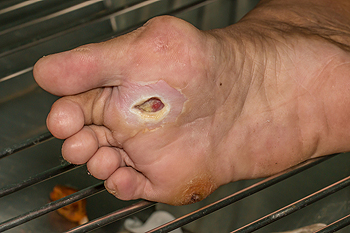 Patients who have diabetes may be aware of the importance of properly caring for their feet. This can help to prevent the painful condition that is known as a diabetic foot ulcer. This type of wound may develop as a result of the inability of feeling a small cut on the foot, and it may quickly become infected. This can happen from elevated glucose levels in the blood, which may hinder the body’s capability to heal properly. Mild relief and proper healing may come from keeping weight off of the foot, and it may help to elevate it often. It is imperative that proper dressings are used as the healing process takes place, in addition to keeping the foot as clean and as dry as possible. If you have diabetes, it is strongly suggested that you seek the counsel of a podiatrist who can properly treat this condition.
Patients who have diabetes may be aware of the importance of properly caring for their feet. This can help to prevent the painful condition that is known as a diabetic foot ulcer. This type of wound may develop as a result of the inability of feeling a small cut on the foot, and it may quickly become infected. This can happen from elevated glucose levels in the blood, which may hinder the body’s capability to heal properly. Mild relief and proper healing may come from keeping weight off of the foot, and it may help to elevate it often. It is imperative that proper dressings are used as the healing process takes place, in addition to keeping the foot as clean and as dry as possible. If you have diabetes, it is strongly suggested that you seek the counsel of a podiatrist who can properly treat this condition.
Diabetic foot care is important in preventing foot ailments such as ulcers. If you are suffering from diabetes or have any other concerns about your feet, contact Dr. Thong V. Truong from California. Our doctor can provide the care you need to keep you pain-free and on your feet.
Diabetic Foot Care
Diabetes affects millions of people every year. The condition can damage blood vessels in many parts of the body, especially the feet. Because of this, taking care of your feet is essential if you have diabetes, and having a podiatrist help monitor your foot health is highly recommended.
The Importance of Caring for Your Feet
- Routinely inspect your feet for bruises or sores.
- Wear socks that fit your feet comfortably.
- Wear comfortable shoes that provide adequate support.
Patients with diabetes should have their doctor monitor their blood levels, as blood sugar levels play such a huge role in diabetic care. Monitoring these levels on a regular basis is highly advised.
It is always best to inform your healthcare professional of any concerns you may have regarding your feet, especially for diabetic patients. Early treatment and routine foot examinations are keys to maintaining proper health, especially because severe complications can arise if proper treatment is not applied.
If you have any questions please feel free to contact our office located in Chico, CA . We offer the newest diagnostic and treatment technologies for all your foot and ankle needs.
Diabetic Foot Care
Diabetes can cause two problems that can potentially affect the feet: Diabetic neuropathy and Peripheral Vascular Disease. Diabetic neuropathy occurs when nerves in your legs and feet become damaged, which prevents you from feeling heat, cold, or pain. The problem with diabetic neuropathy is that a cut or sore on the foot may go unnoticed and the cut may eventually become infected. This condition is also a main cause of foot ulcers. Additionally, Peripheral vascular disease also affects blood flow in the body. Poor blood flow will cause sores and cuts to take longer to heal. Infections that don’t heal do to poor blood flow can potentially cause ulcers or gangrene.
There are certain foot problems that are more commonly found in people with diabetes such as Athlete’s foot, calluses, corns, blisters, bunions, foot ulcers, ingrown toenails, and plantar warts. These conditions can lead to infection and serious complications such as amputation. Fortunately, proper foot care can help prevent these foot problems before they progress into more serious complications.
Each day you should wash your feet in warm water with a mild soap. When you finish washing your feet, dry them carefully especially between your toes. You should also perform daily foot inspections to ensure you don’t have any redness, blisters, or calluses. Furthermore, if you are diabetic, you should always wear closed-toed shoes or slippers to protect your feet. Practicing these tips will help ensure that your feet are kept healthy and away from infection.
If you have diabetes, contact your podiatrist if you have any of the following symptoms on your feet: changes in skin color, corns or calluses, open sores that are slow to heal, unusual and persistent odor, or changes in skin temperature. Your podiatrist will do a thorough examination of your feet to help treat these problematic conditions.
The Importance of Elderly Foot Care
One of the most important things elderly people can do is to properly care for their feet. Many seniors can experience uncomfortable foot conditions as a result of a loss of cushioning as the aging process occurs. Research has indicated that one of the most favorable things seniors can do for their feet is wear shoes that fit correctly. The feet will feel better when there is adequate room for the toes to move freely in, and this may be helpful in preventing corns and bunions from developing. Additionally, washing and drying the feet daily followed by using a good moisturizer may be beneficial in preventing cracked heels. If you would like additional information about how elderly patients can care for their feet, please consult with a podiatrist.
Proper foot care is something many older adults forget to consider. If you have any concerns about your feet and ankles, contact Dr. Thong V. Truong from California. Our doctor can provide the care you need to keep you pain-free and on your feet.
The Elderly and Their Feet
As we age we start to notice many changes in our body, but the elder population may not notice them right away. Medical conditions may prevent the elderly to take notice of their foot health right away. Poor vision is a lead contributor to not taking action for the elderly.
Common Conditions
- Neuropathy – can reduce feeling in the feet and can hide many life-threatening medical conditions.
- Reduced flexibility – prevents the ability of proper toenail trimming, and foot cleaning. If left untreated, it may lead to further medical issues.
- Foot sores – amongst the older population can be serious before they are discovered. Some of the problematic conditions they may face are:
- Gouging toenails affecting nearby toe
- Shoes that don’t fit properly
- Pressure sores
- Loss of circulation in legs & feet
- Edema & swelling of feet and ankles
Susceptible Infections
Diabetes and poor circulation can cause general loss of sensitivity over the years, turning a simple cut into a serious issue.
If you have any questions please feel free to contact our office located in Chico, CA . We offer the newest diagnostic and treatment technologies for all your foot and ankle needs.
